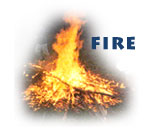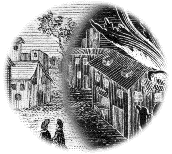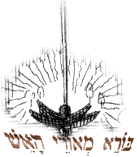|
|


|
The
Havdalah (lit. "separation") ceremony is recited
at the conclusion of the Sabbath and festivals to mark the distinction
between the departing sacred day and the ordinary weekday that is
beginning. One of the most ancient blessings, it is preceded by
a number of scriptural verses and three blesssings — over wine,
spices, and light — all comprising the Havdalah ceremony. |

The flame lit
during the Havdalah ceremony represents, and thereby commemorates,
the first fire, said to have been created by Adam with divine assistance
on the night following the Sabbath of Creation.
 We
had been taught that R. Yose said: It had been God's intention to
create fire on the eve of the Sabbath, but it was not created until
Sabbath's outgoing. At the Sabbath's outgoing, the Holy One gave
Adam the kind of knowledge like the knowledge above, so that Adam
fetched two stones and rubbed one against the other. From between
them fire came forth, and over it Adam uttered the blessing "Blessed
by Thou' who created diverse lights of fire."[1] We
had been taught that R. Yose said: It had been God's intention to
create fire on the eve of the Sabbath, but it was not created until
Sabbath's outgoing. At the Sabbath's outgoing, the Holy One gave
Adam the kind of knowledge like the knowledge above, so that Adam
fetched two stones and rubbed one against the other. From between
them fire came forth, and over it Adam uttered the blessing "Blessed
by Thou' who created diverse lights of fire."[1]
The understanding
that man's creative abilities are ultimately rooted in God and
His wisdom is commemorated with a blessing. As Adam recites this
blessing at the conclusion of the Sabbath, it is included as part
of the Havdalah ceremony. At the same time, because it
is also the first thing the individual produces by his own efforts
after resting throughout the Sabbath, it also exemplifies creative
human activity.
Writes Josef Stern: "Among the many accounts and myths found
throughout ancient literature in which the creation of fire is
used to exemplify human creativity, the talmudic version of Adam's
act aided by God and commemorated with a blessing[2]
is unique, especially (as the late Saul Lierberman observed) in
contrast to the Prometheus myth, in which man steals the original
fire from Zeus and is punished for his act. For in making a blessing
over the flame he brings into being, the individual acknowledges
that the product of his own apparently free, creative action is
ultimate due to God."[3]
The first-century
school of Shammai determined that the formula recited over the
light should be, "Who created the light of the fire."
The school of Hillel, however, maintained that since there are
many colors of fire, it was necessary to say, "Who created
the lights of fire" in the plural[4]
and the halakhah was established accordingly.
According to the halakha
(religious law), birkhot ha-nehenin ("blessings for things
enjoyed")[5]
cannot be recited unless there is actual benefit from the object blessed;
the light over which the blessing is made must serve some other immediate
and practical purpose. Hence the individuals participating in the havdalah
ceremony and reciting the blessing over the flames, turn the palm of their
hands, using the light to observe their fingernails and to distinguish light
from shadow.
|
[1]
BT Pes. 54a; Bereishit Rabbah 11 [back]
 [2]
BT Berakhot 8:6 [back]
[3] Josef Stern, "Gesture
and Symbol" in Contemporary Jewish Religious Thought,
ed. Arthur a. Cohen and Paul Mendes Flohr, Copyright © 1987
by Charles Scribner's Sons. [back]
[4] Berakhot 52a [back]
[5] Birkhot ha-nehenin are
those blessings recited over things providing pleasure such
as food and
drink; also included in this category are benedictions recited
over enjoying the aroma of fragrant flowers or spices. [back]
|
FIRE Table of Contents
|
|
|
|